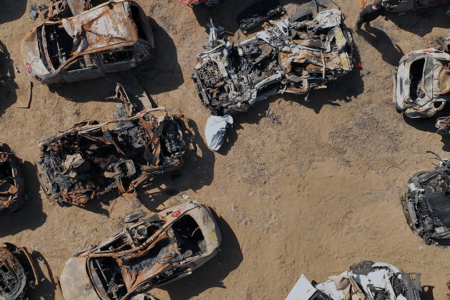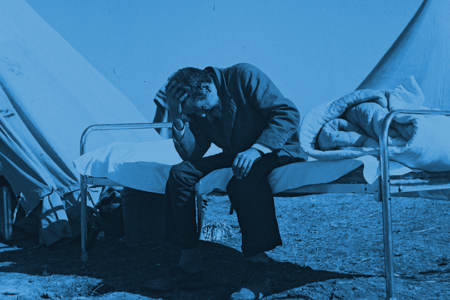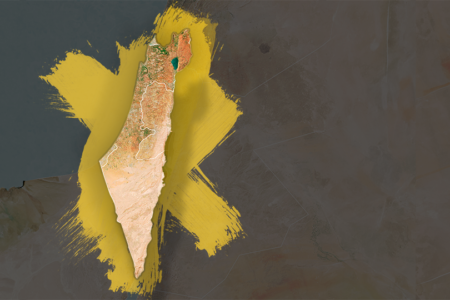The Tabernacle
Shadows of the Saviour
“I’ve been to the mountain, and I have seen the glory of the Lord,” would be the testimony of Moses if he were here today. Just think of the piercing words Moses heard when God thundered from Mount Sinai, “. . . Come up to me . . . .” (Ex. 24:12). How he must have sensed the drawing power of God when he left Aaron, Hur, Joshua and the elders of Israel to ascend into the presence of God! What awe must have filled his being when at the summit he experienced the envelopment of God’s glory!
For six days Moses would sit in silent contemplation waiting for direction from God. Then suddenly, the silence was broken on the seventh day, when God spoke to Moses out of the cloud:
Speak unto the children of Israel . . . And let them make me a sanctuary, that I may dwell among them. According to all that I show thee, after the pattern of the tabernacle, and the pattern of all the furnishings thereof, even so shall ye make it (Ex. 25:2, 8, 9).
Just think, the God of Israel who had redeemed them from the bondage of Egypt, revealed His glory to them on Mount Sinai and given them His law to live by, will now condescend to dwell in their midst. What joy must have swept over Moses when he saw the tabernacle which he was to build appear before his eyes and heard that the “God of the universe would dwell among them.”
The tabernacle is of such great importance to God’s redemptive program that at least sixteen chapters in the Book of Exodus are given to explaining its pattern, construction and service. Nothing was to be left to Moses’ speculation, but God revealed to him in minute detail every aspect of the tabernacle; over twenty times in Exodus we read, “as the Lord commanded Moses”.
There are five names used in Scripture to describe the tabernacle. It is called a “sanctuary” (Ex. 25:8) denoting that it is set apart for a holy God. The term “tabernacle” (Ex. 25:9) reveals that it would be the dwelling place of God among His people. The word “tent” (Ex. 26:36) designates it as a temporary dwelling place of God. It is called the “tabernacle of the congregation” (Ex. 29:42) because it was where God met with His people. The final expression, “tabernacle of testimony” (Ex. 38:21), was descriptive of the law given to Moses which was kept in the ark of the covenant located in the holy of holies. What an appropriate appellation given to the tabernacle which stood testifying to Israel and the world of God’s truth and glory.
The Purpose of the Tabernacle
For almost five hundred years the tabernacle was to serve as a place for God to dwell among His people and a place for His people to commune with Him (Ex. 25:8; 40:34-37). Throughout Israel’s history there was a propensity toward idolatry; thus, the tabernacle would stand as a visual reminder to Israel that they served the “true and living God”. It would help keep Israel from the idol worship which was practiced by those living around them as they made their pilgrimage in the wilderness.
Even though the tabernacle made God accessible to the Israelites, He was only approachable in holiness. The structure and service of the tabernacle showed a sinful people how they could come before a holy God in worship and service (Ex. 29:42-43, 45); offer sacrifice for sin (Lev. 1-7; 16-17); and receive instruction and counsel from the Word of God. Thus, it was a graphic portrayal of God’s redemptive program for Israel. Every aspect of the tabernacle, from the brazen altar where sacrifice was offered for sin to the mediating high priest who offered the sacrificial blood on the mercy seat, pointed to God’s redemptive plan. Man could only approach a holy God through a blood atonement and a mediating priesthood.
How beautifully this is typified in the ministry of Jesus the Messiah, who left His throne in heaven (Heb. 2:16-17), and tabernacled among us (Jn. 1:14). In Christ we have a high priest, a perfect blood sacrifice (Heb. 9:11-15), and access to God for all who put their trust in Him (Heb. 4:15-16).
The Pattern of the Tabernacle
The tabernacle was an ingenious prefabricated structure which could be moved at will. Its construction was a cooperative task between God and man. The Lord provided the pattern of the tabernacle (Ex. 25:9); the people were to provide the materials (Ex. 25:37) by bringing an offering with a “willing heart” (Ex. 25:2). The offering which they brought was gold, silver, brass, jewels, fine linens and dye from Egypt; goat hair and ram skins came from their flocks; seal skins (porpoises) from the Red Sea; the shittim (acacia) wood from the Sinai. Notice that Moses was instructed to take the offering only if it came from a “willing heart”. Today, God desires for His people to give themselves to His service first (Rom. 12:1), and then to bring their gifts, not grudgingly or of necessity (2 Cor. 9:7), but willingly for His work. God’s plan has always been to accomplish His purposes through a redeemed people.
The tabernacle was the focal point of Israel’s community and life, with the tribes dwelling around its four sides (Num. 2). The outer court was 150 feet long and 75 feet wide, enclosed by a fine twine linen curtain 7 1/2 feet high. Its gate was 30 feet wide, placed on the east side of the court. On entering the court, one was overwhelmed at the beautiful furnishings of gold and brass which were dazzling when gazed upon.
The furniture and its placement, from the brazen altar to the mercy seat, typified the various ministries of Christ on our behalf (Heb. 8:1-6). The tabernacle with its ordinances was only a “figure for the time then present” (Heb. 9:9), but looked toward Christ’s sacrificial death which was to mediate a new covenant by means of His shed blood for the redemption of mankind (Heb. 9:11-22). The earthly tabernacle is only a figure of the true tabernacle in heaven where Christ is enthroned in His high-priestly ministry (Heb. 9:23-24).
The brazen altar stood in the outer court just inside the gate facing the tabernacle (Ex. 40:6). It was upon this altar that the sacrificial animal was offered up and its blood shed for the sins of the people. The brazen altar typifies Christ’s redemptive work on the cross on our behalf, whereby all who put faith in His shed blood are justified and receive remission of sins (Rom. 3:24-25). As it was impossible for the Israelite to come into God’s presence without a sacrifice at the brazen altar, so it is impossible for us to come into the presence of God except by the ministry of the cross.
The brazen laver stood in the outer court between the brazen altar and the tabernacle. The laver was provided only for the priest, who must wash before entering into the tabernacle. As he washed in the laver, mirrors reflected his image reminding him of how God sees him. The laver speaks of Christ as our sanctification. As believer-priest, we are reminded that Christ has sanctified us for His service and is sanctifying us by cleansing us from the daily defilement of sin with the washing of water by His word (Eph. 5:26).
From the laver, the priest walked a few paces to the tabernacle, drew back the curtain and entered into the holy place which allowed him to have fellowship with God. There were three pieces of furniture in the holy place which typify our fellowship with Christ. First, the table of showbread stood on the right side in the holy place. The twelve loaves on the table were a meal offering representing the twelve tribes of Israel. The showbread typified Christ who came down from heaven, and all who partake of Him have eternal life (Jn. 6:51). As the Bread of Life, Christ sustains the believer-priest who feeds on Him.
On the left side of the holy place stood the seven-branched golden lampstand. The lampstand speaks of Christ who would be the light of the world (Isa. 42:6; 49:6; Jn. 9:5). All those who trust in Him are given the light of life (Jn. 8:12). We are to hold forth the light of God’s Word in this darkened world (Phil. 2:15-16), so that men can see our good works and glorify our Lord (Matt. 5:14-16). The glory of Christ will light up the New Jerusalem which will be our dwelling place throughout eternity (Rev. 21:23).
The altar of incense stood in the holy place right in front of the veiled holy of holies. Burning coals from the brazen altar were placed on the altar of incense over which sweet incense was poured daily. The smoke from the incense curled upward representing the prayers of God’s people (Ps. 141:2; Rev. 5:8). The altar typifies Christ our High Priest who intercedes for us before the Father’s throne (Jn. 17; Heb. 7:25), and the believer priest who offers up the sacrifice of praise unto the Lord (Heb. 13:15).
The heavy veil which hung between the holy place and the holy of holies separated a holy God from a sinful people. Christ represents the veil separating men from God. At His death on the cross, the veil was rent from top to bottom (Matt. 27:51), opening the way to God through His shed blood (Heb. 10:19), so we could come boldly unto the throne of grace that we may obtain mercy (Heb. 4:16).
Inside the holy of holies sat the ark of the covenant, a rectangular box covered with gold inside and out. On top of the ark stood two cherubim of gold facing each other, but looking down toward the mercy seat with their wings stretched out over it. It was on the mercy seat that the high priest would come and sprinkle blood on the Day of Atonement, which enabled God to cover the sins of the high priest and the people. Patiently, the people waited outside the tabernacle with their eyes fixed on it. Wondering whether the high priest would reappear. If he reappeared, God had accepted the blood atonement and their sins were covered for another year. Christ as our High Priest (Heb. 7:24-25) offered His own blood to put away our sin (Heb. 9:25-26) and is our propitiation (Rom. 3:25; 1 Jn. 2:2), satisfying the righteous demands of a holy God for the judgment of sin, opening the way for Him to freely forgive us.
How beautiful it is to see the shadowy patterns of the tabernacle fulfilled in Jesus the Messiah, who has justified us by His blood, cleanses and feeds us through His Word, lights up the path before us and intercedes for us along the way; and because of Him, we have access through the veil to the throne of grace that we may obtain mercy on the merit of His blood which has put away our sin.
The Prefigures of the Tabernacle in the Church
The tabernacle prefigures the Church. Paul states that the Church is “a holy temple in the Lord . . . for an habitation of God through the Spirit” (Eph. 2:21-22). The word “temple” is not the temple with all its porches and surrounding buildings, but the inner sanctuary – the holy of holies. Today, God does not dwell in a physical structure but in a spiritual body called the Church. The figure is very impressive! The temple was holy and set apart for God’s service, and so the Church is holy and consecrated to His service. Collectively, God dwells in each believer by the Holy Spirit, forming us into His temple. The nation of Israel never experienced this. Only the high priest was able to enter into the holy of holies and thus stand in the presence of God, and that only once a year. This privilege should cause each one in the Church to walk circumspectly before the Lord.
The tabernacle also prefigures the individual Christian, Paul says, “Know ye not that your body is the temple (sanctuary) of the Holy Spirit who is in you, whom ye have of God, and ye are not your own?” (1 Cor. 6:19). As a sanctuary where the Spirit of God dwells, we are not at liberty to allow our bodies to be used outside of His designed purposes for us.
Conclusion
The central truth of the tabernacle is that God condescended to dwell among men. The tabernacle, with its many symbols and types, was a shadow pointing to the Savior who, in the fullness of God’s time, would be tabernacled in this world and would open the way for God to bring redemption to mankind. The writer of the Book of Hebrews so aptly sums up Christ’s ministry when he states:
But Christ being come an high priest of good things to come, by a greater and more perfect tabernacle, not made with hands, that is to say, not of this building, Neither by the blood of goats and calves, but by his own blood he entered in once into the holy place, having obtained eternal redemption for us (Heb. 9:11-12).
In future lessons we will took at the ministry of the tabernacle as it is fulfilled in Christ. May the words, “I’ve been to the mountain, and I have seen the glory of the Lord,” be your testimony through this study as the shadows of the tabernacle set forth the reality of the Savior.







